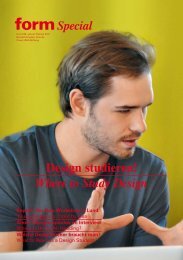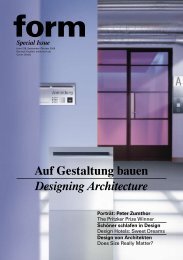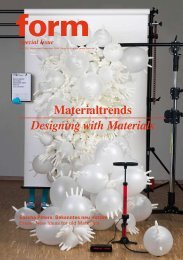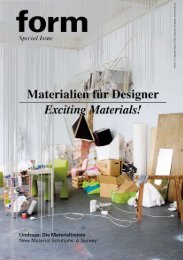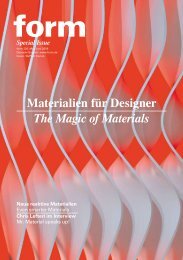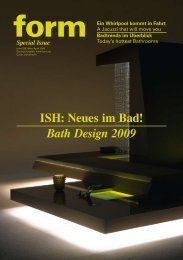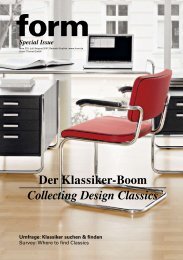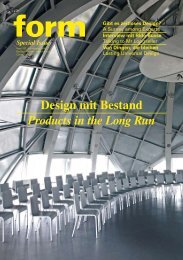Neue Material-Ideen! Fascinating Materials Special - Form
Neue Material-Ideen! Fascinating Materials Special - Form
Neue Material-Ideen! Fascinating Materials Special - Form
Erfolgreiche ePaper selbst erstellen
Machen Sie aus Ihren PDF Publikationen ein blätterbares Flipbook mit unserer einzigartigen Google optimierten e-Paper Software.
Advertorial Rubrik<br />
form 235, November / Dezember 2010<br />
Deutsch / English, form.de<br />
Cover: Pixelgarten for BASF designfabrik<br />
<strong>Special</strong><br />
<strong>Neue</strong> <strong>Material</strong>-<strong>Ideen</strong>!<br />
<strong>Fascinating</strong> <strong>Material</strong>s<br />
form 209 / 2010 Content 1
2 Content form 209 / 2010<br />
JETZT BESTELLEN!<br />
BIRKHAUSERARCHITECTURE.COM, SALESBIRKHAUSER.CH<br />
DIE BESTEN ARCHITEKTEN<br />
IN EINEM BUCH!<br />
<br />
AUSGEZEICHNETES NACHSCHLAGEWERK<br />
INTERESSANTE PROJEKTE MIT HINTERGRUNDINFORMATIONEN<br />
EINZIGARTIGE EINBLICKE IN DIE AKTUELLE ARCHITEKTURSZENE<br />
ERSCHEINT IM HERBST 2010<br />
ISBN: 9783034606127, DEUTSCH/ENGLISH, EUR 49.90<br />
Alle drei Jahre wieder: Noch bis zum 3. November findet in<br />
Düsseldor f die achtzehnte K-Messe statt und präsentiert Neuigkeiten<br />
aus der großen, bunten und geheimnisvollen <strong>Material</strong>welt.<br />
Trotz sämtlicher Krisen hält sie mit rund 3100 Ausstellern aus<br />
57 Ländern das Niveau von 2007. Acht Tage lang dreht sich in den<br />
Düsseldorfer Messehallen alles um Kunststoff- und Gummimaschinen,<br />
um Energieeffizienz, um Innovationen und Entwicklungen.<br />
Grund genug für uns, dem Thema ein Sonderheft zu widmen:<br />
Auf den folgenden Seiten werden Sie Myon kennenlernen, einen<br />
Roboter mit großem Kullerauge. Dank spezieller Flansche können<br />
seine sechs Gliedmaßen unabhängig voneinander abgetren nt<br />
und ausgetauscht werden – außerdem eignen sie sich autark<br />
Wisse n an. Und es tut sich etwas auf dem Plastikbesteckmarkt:<br />
ding3000 haben in Kooperation mit BASF ein Set aus Gabe l,<br />
Messe r und Löffel entwickelt, das nicht nur richtig gut schneiden<br />
kann, sondern auch als dekorative Tischskulptur taugt. Last but<br />
not least berichten Nina Saller und Michael Lanz von Designaffairs<br />
aus München von ihrem aktuellen Projekt: dem neu eröffneten<br />
<strong>Material</strong> Dock.<br />
Wir wünschen Ihnen jede Menge Inspiration und viel Spaß<br />
beim Lesen!<br />
Rahel Ueding<br />
<strong>Special</strong><br />
Editorial<br />
<strong>Neue</strong> <strong>Material</strong>-<strong>Ideen</strong>!<br />
<strong>Fascinating</strong> <strong>Material</strong>s<br />
Every three years for certain: The 18th K Trade Fair is being held<br />
in Düsseldorf until November 3, and will be showcasing innovations<br />
from the large, colorful and mysterious world of materials. For all<br />
the crises, some 3,100 exhibitors from 57 different countries will<br />
be attending, which is on a par with 2007. For eight whole days,<br />
everything in the trade fair complex in Düsseldorf will focus on plastic<br />
and rubber machines, on energy efficiency, on innovations and<br />
development s. We felt this was reason enough to dedicate a special<br />
supplement to the subject. In it you will get to know Myon, a robot<br />
with a large round eye. Thanks to special technology, its individual<br />
body parts can be removed without this impairing functionality –<br />
moreover, they independently acquire knowledge. And things are<br />
moving on the plastic cutlery market: in collaboration with BASF,<br />
ding3000 has developed a set consisting of knife, fork and spoon<br />
that not only boasts a knife that really cuts, but can also definitely<br />
be used as decorative additions to the set table. Last but not least,<br />
Nina Saller and Michael Lanz from Designaffairs in Munich tell<br />
us all about their latest project: the newly launched <strong>Material</strong> Dock.<br />
Wishing you inspiration and a lot of fun reading our specia l issue!<br />
Rahel Ueding<br />
Das Coverfoto stammt von Pixelgarten. Es zeigt ein ebenso formschönes<br />
wie funktionales Plastikbesteck, das ding3000 in Kooperation<br />
mit BASF entwickelt haben. Das dazugehörige Making of lesen Sie ab<br />
Seite 4; basf.com; ding3000.com; konstantinslawinski.com<br />
The cover photo was shot by Pixelgarten. It shows a cutlery made<br />
of durabl e plastic, designed by ding3000 in cooperation with BASF.<br />
Read more about it in our Making of starting from page 4.<br />
basf.com; ding3000.com; konstantinslawinski.com<br />
Imprint: <strong>Fascinating</strong> <strong>Material</strong>s – A special issue by form magazine<br />
Birkhäuser GmbH, Viaduktstrasse 42, CH-4051 Basel<br />
T: + 41.61.56898-00, F: + 41.61.56898-99, form.de, form@form.de<br />
Edited by: Rahel Ueding, rahel.ueding@form.de,<br />
Christoph Konetschny, materialsgate.com<br />
Head of Media: Anne Ott, T: + 49.89.33019903, M: + 49.172.8989860<br />
<strong>Material</strong>s 3
4 <strong>Material</strong>s<br />
Schnittiges Besteckspiel<br />
Cutting Edge Design<br />
Splitternd, schmelzend und stumpf: Kunststoffbesteck<br />
hat einen schlechten Ruf. Doch das Designbüro<br />
ding3000 rettet die Ehre des <strong>Material</strong>s. Ihr<br />
dreiteiliges Besteck Join aus Ultramid kann sogar<br />
mehr als schneiden.<br />
Hochwertige Bestecke haben in Deutschland Tradition.<br />
Als noch zu jeder Mitgift ein vielteiliges Essbesteck<br />
aus Edelstahl oder Silber gehörte, boomte die<br />
Besteckproduktion bei Firmen wie WMF oder Rosenthal.<br />
Doch hochwertige Sets aus Kunststoff bildeten<br />
selbst in den kunststoffverliebten siebziger<br />
Jahren eher die Ausnahme – auch wenn sich einige<br />
renommierte Gestalter und Firmen daran versuchten.<br />
Meist waren es die Griffe, die mit Kunststoff beleg<br />
t wurden, etwa bei Clip von Peter Raacke (1975).<br />
Der Kunststoff sollte das Halten des Bestecks angenehmer<br />
machen und für einen zeitgemäßen Look<br />
sorgen. Die drei Gestalter von ding3000 aus Hannover,<br />
die nun mit Unterstützung der BASF designfabrik<br />
für die Firma Konstantin Slawinski ein Kunststoffbesteck<br />
entwickelten, dachten weiter.<br />
Alles begann mit dreidimensionalen Puzzles, die<br />
sich die Designer zur Inspiration im Internet bestellten.<br />
Dabei fiel ihnen ein einfaches japanisches Kinderspielzeug<br />
auf, bei dem drei Stäbchen scheinbar<br />
Text: Petra Schmidt (redaktion@form.de)<br />
untrennbar mit einem Kreuzknoten verbunden werden.<br />
Ein Hölzchen mit einer länglichen Bohrung wird<br />
mit zwei eingekerbten Hölzern so ineinander gefügt,<br />
dass sie eine Skulptur bilden, die so stabil aufrecht<br />
steht, als hätte man die Teile verleimt. Ein interessantes<br />
Objekt, aber die Idee musste reifen. „Es hat<br />
eine Weile gedauert. Wir brauchten etwas, das sich<br />
auf drei reimt“, erklärt Ralph Webermann. „Schließlich<br />
kamen wir auf das Dreiergespann, Gabel, Messer,<br />
Löffel.“ Wenn sie heute über den Entwurf sprechen,<br />
zeigen sie gerne die kleinen Originalhölzchen,<br />
an die sie aus einfacher Pappe Forke, Laffe und<br />
Schneide geklebt hatten. Im Vergleich zum fertigen<br />
Besteck, das zierlich geformt ist, wirkt das Model l<br />
unbeholfen und rustikal. Aber eines wurde Carsten<br />
Schelling schon damals klar: „Wir hatten plötzlich<br />
nicht nur ein Besteck, sondern eine neue <strong>Form</strong> von<br />
Tischdekoration! Das Falten von Serviettenschwänen<br />
kann man sich jetzt wirklich schenken, außerdem<br />
lässt sich die Wartezeit vor dem Essen wunderbar<br />
mit Knobeln verkürzen.“<br />
Zunächst dachten die Designer daran, den Entwurf<br />
in Edelstahl zu realisieren. Als sie jedoch das<br />
Besteck dem Produzenten Konstantin Slawinski vorstellten,<br />
wurde schnell deutlich, dass die U msetzung<br />
in Metall problematisch wäre. „Es gibt keine ,kleinen‘<br />
Hersteller auf dem Markt. Wir hätten zu den gro -<br />
ßen deutschen Besteckproduzenten gehen müssen,<br />
dann wäre es aber enorm teuer geworden.“ Vor diesem<br />
Hintergrund entstand die Idee, in Kunststoff<br />
zu fertigen und in puncto Werkstoffwahl, Lebensmittel<br />
kontaktzulassung und fertigungstechnischem<br />
Know-how die BASF designfabrik in Ludwigshafen<br />
anzufragen. „Ich hatte mich an den Stuhl Myto von<br />
Konstantin Grcic erinnert, der mit BASF-<strong>Material</strong>ien<br />
und dem entsprechenden Know-how entwickelt<br />
wurde“, erläutert Rudolph. Wenn schon kein Edelstahl,<br />
dann sollte es zumindest ein hochwertiger<br />
Kunststoff sein. Schließlich wol lte man kein Weg-<br />
werfbe steck produzieren.<br />
Die designfabrik in Ludwigshafen<br />
unterstützt Gestalter bei der<br />
Aus wahl der richtigen Kunststoffe<br />
aus dem BASF-Sortiment sowie bei<br />
der technischen Umsetzung ihrer<br />
Produkt ideen. Mitarbeiterin Sandra<br />
Hermanns etwa hat selbst Design<br />
stu diert und hilft bei der Behebung<br />
von Schwachstellen. „Insbesondere<br />
für den Löffel und die Gabel, die<br />
durch Einkerbungen am Griff in ihrer<br />
Stabilität stark geschwächt sind,<br />
Prototyp im Test: Mit dem von<br />
ding3000 entworfenen Kunststoffmesser<br />
aus der Join-Serie lässt<br />
sich sogar harte Salami schneiden –<br />
dank des Klingendesigns, aber auch<br />
dank des verwendeten <strong>Material</strong>s<br />
Ultramid, einem speziellen Polyamid.<br />
Oben: Erste Vorstudien.<br />
Left page: Thanks to its design, but<br />
also to the material used, the special<br />
polyamide Ultramid, the knife in<br />
the Join series designed by ding3000<br />
even cuts through hard salami. This<br />
page: initial preliminary studies.<br />
benötigt man einen extrem haltbaren Kunststoff.<br />
Gerade am Griff wird auf die Fügestelle starker<br />
Druck ausgeübt, darum haben unsere Spezialisten<br />
den stabilen Kunststoff Ultramid empfohlen und<br />
diesen auch anhand eines virtuellen Prototypen mit<br />
dem Simulationswerkzeug Ultrasim getestet und<br />
optimiert,“ erläutert Hermanns. „Aufgrund des stabilen<br />
<strong>Material</strong>s ist es uns gelungen, ein filigranes Besteck<br />
mit dünnen Wandstärken zu entwerfen“, hebt<br />
Designer Carsten Schelling hervor. Und anders als<br />
bei den meisten herkömmlichen Kunststoffgabeln<br />
sind insbesondere die Zinken der Forke sehr spitz.<br />
Bleibt nur noch die eine, alles entscheidende Frage:<br />
Kann man mit ei nem Kunststoffmesser<br />
gut schneiden? „Natürlich“,<br />
so Sven Rudolp h. „Jeder von uns<br />
hat sich wohl schon mal an einer<br />
scharfen Kunststoffkante geschnitten.<br />
Das Problem ist nicht so sehr<br />
die Schärfe; schwieriger ist es, die<br />
Klinge mit einer schönen und haltbaren<br />
Wellenform zu versehen.“<br />
Da rum ging er bei Messerschleifern<br />
sowie im Deutschen Klin genmu seum<br />
in Solingen auf die Suche nach<br />
dem perfekten Schliff. Dort fand er<br />
<strong>Material</strong>s 5
6 <strong>Material</strong>s<br />
heraus, dass die großen Wellen eines Steakmessers<br />
sich sehr schnell abnutzen. Es wird dabei nicht<br />
stumpf, sieht aber abgewetzt aus. „Die feine Riffelung,<br />
die wir nun für das Messer gefunden haben,<br />
wird auch nach längerem Gebrauch noch ihre <strong>Form</strong><br />
beibehalten“, meint Sven Rudolph. Und dank der<br />
Hitzebeständigkeit von Ultramid wird die Schneide<br />
ganz sicher nicht wie bei handelsüblichen Einwegbestecken<br />
schon beim Schneiden einer heißen Grillwurst<br />
dahinschmelzen.<br />
Splintering, melting, blunting: Cutlery made of plastics<br />
has a bad reputation. The German design studio<br />
ding3000 now raises its reputation: Their cutlery<br />
Join made from Ultramid is not only able to cut<br />
things. It also makes you play with it!<br />
High-quality cutlery has a long-standing tradition in Germany.<br />
Back when a full set of silverware made of stainless<br />
steel or silver was a must in every dowry, cutlery<br />
productio n was booming at companies such as WMF<br />
and Rosenthal. High-end sets made of plastic, however,<br />
have always been more of an exception, even in the plastic-crazy<br />
1970s, although a few major designers and renowned<br />
companies did try their hand at it. For the most<br />
part, it was the handles that were coated with plastic,<br />
such as, for example, in the Clip series created by the<br />
well-known German designer Peter Raacke. The plastic<br />
was intended to make the utensil more comfortable to<br />
hold. The three designers from ding3000 studio in Hannover<br />
now have developed things further with their plastic<br />
cutlery set for the Konstantin Slawinski company with<br />
support of BASF’s designfabrik.<br />
It all started with brainteasers and three-dimensional<br />
puzzles that the designers ordered on the Internet as<br />
sources of inspiration. They had noticed a very simple<br />
Japanese toy where three small sticks are joined – apparently<br />
inseparably – with a so-called “square knot.” In<br />
this toy, a wooden stick with an elongated opening is intertwined<br />
with two notched sticks in such a way that<br />
they form a small sculpture that stands so securely that<br />
it seems as if the parts have been glued together. It was<br />
an interesting object but apparently, this was just the<br />
seed of an idea. “It took a while. We needed something<br />
that came in ‘threes’”, explains Ralph Webermann. “Ul<br />
timately, we came up with the trio<br />
made up of fork, knife they form a<br />
small sculpture that stands so securely<br />
that show the three original wooden<br />
sticks onto which they glued a fork,<br />
knife and spoon.” When they talk about<br />
this now, they eagerly show the three<br />
original wooden sticks onto which they<br />
glued a fork, knife and spoon made of<br />
simple cardboard. In comparison to the<br />
finished utensils, which are delicate in<br />
shape, the original model still looks<br />
clumsy and crude. But one thing became<br />
clear to Carsten Schelling, even<br />
in the wooden model. “All of a sudden,<br />
Links: Ralf Webermann arbeitet an<br />
den Konturen des Löffels. In ersten<br />
Entwürfen waren die Besteckgriffe<br />
noch wie Kettenglieder geformt.<br />
Oben: Spritzgussform und erste Ergebnisse,<br />
die dem Endprodukt<br />
schon sehr nahe kamen und Silhouetten<br />
der Join-Gabel – in progress.<br />
Left: Ralf Webermann working on<br />
the contours for the spoon. In the<br />
first sketches the cutlery’s handles<br />
still look like the links of a chain.<br />
Above: Injection mold and first results<br />
that looked very much like the<br />
final product. Next to it: Silhouettes<br />
of the Join fork – work in progress.<br />
what we had here was not only a utensil but in fact, a<br />
completely new form of table decoration! Now you can<br />
really forget about folding all those nap kins into the shape<br />
of swans, and besides, time spent wait ing for the meal<br />
can be spent toying with the puzzle.”<br />
At first, they thought of implementing their invention<br />
in stain less steel. But when they presented their cutlery<br />
set to the producer Konstantin Slawinski, it quickly became<br />
clear that there would be dif ficul ties with a metal<br />
version: “There are no small manufacturers on the market.<br />
We would have had to approach the major German<br />
cutlery producers, but this would have made the cutlery<br />
expensive.” So they decided to use plastic and to con<br />
tact BASF’s designfabrik in Ludwigshafen<br />
for help with the aspects of material<br />
selection, approval for contact<br />
with food, and production knowhow.<br />
“I remembered the Myto chair created<br />
by Konstantin Grcic, which had been<br />
developed with BASF materials and<br />
knowhow,” says Sven Rudolph. If not<br />
steel, then at least it had to be a highgrade<br />
plastic. After all, it was not the<br />
goal to produce disposable cutlery.<br />
The designfabrik in Ludwigshafen assists<br />
designers in selecting and combining<br />
plastics from BASF’s lineup,<br />
and it also provides technical support<br />
<strong>Material</strong>s 7
8 <strong>Material</strong>s<br />
so that their product ideas can be implemented. One<br />
of the designfabrik’s employees, Sandra Hermanns, provides<br />
her input to remedy any weak spots that might be<br />
encountered. “Especially the spoon and the fork, where<br />
the notches in the handle greatly impair the stability,<br />
have to be made of an extremely strong plastic. Their<br />
handles are exposed to a great deal of pressure at the<br />
joining line; this is why our specialists recommended<br />
the sturdy plastic Ultramid, which was then tested and<br />
optimized on a virtual prototype using the Ultrasim simulation<br />
tool.” And Schelling continues: “Thanks to this<br />
sturdy material, we have managed to create filigree<br />
utensils with thin walls.” In contrast to most plastic<br />
forks, the prongs of this fork are very pointed.<br />
All that remains is one crucial question: Does a plasti<br />
c knife really cut well? “Of course,” explains Sven<br />
R udolph. “Most of us have already cut ourselves on a<br />
sharp plasti c edge. The problem is not so much the<br />
sharpness. What is much more difficult is to give the<br />
blade an attractive and durable serrated edge.” This is<br />
why the designer sought advice from professional knife<br />
sharpeners and visited the German Blade Museum in<br />
Solingen in search of the perfect edge. He found that the<br />
large serrations of a steak knife very quickly wear down.<br />
It does not become dull, but it looks worn out. “The fine<br />
fluting that we have now created for the knife will retain<br />
its shape, even after prolonged use,” says Rudolph. And<br />
one thing is for sure: owing to the heat resistance of Ultramid,<br />
the edge will not melt away and become dull,<br />
which often happens with regular disposable utensils<br />
when you cut into a sausage that is hot off the grill.<br />
ding3000.com<br />
designfabrik.basf.com<br />
konstantinslawinski.com<br />
Sven Rudolph (li.) und Carsten<br />
Schelling besprechen Details von<br />
Join. Unten: Endlich! Löffel, Gabeln<br />
und Messer in fröhlichen Farbvarianten,<br />
zusammengesteckt zu<br />
kleinen Skulpturen. Das Besteck<br />
feiert am 27. Oktober auf dem<br />
BASFStand der KMesse in Düsseldorf<br />
Premiere.<br />
Designers Sven Rudolph (l.) and<br />
Carsten Schelling discussing details<br />
of Join. Bottom: Spoons, forks and<br />
knives in bright colors, put together<br />
to form table sculptures. The cutlery<br />
will be premiered on October 27 at the<br />
BASF stand at K 2010 in Düsseldorf.<br />
04444_jo106_an_09<br />
GESTALTEN MIT PRODUKTEN<br />
Hochwertige Präsentationskarten<br />
für Ihre professionelle Bemusterung<br />
Einfach kostenlos bestellen:<br />
www.heinze.de/create
10 <strong>Material</strong>s<br />
Der kleine Zyklop<br />
The Little, Learning Robot<br />
Text: Kathrin Spohr (redaktion@form.de)<br />
Ein süßer Fratz! Myon besteht aus<br />
sechs Körperteilen, die sich ihr<br />
Wissen unabhängig voneinander<br />
aneigen. Mittels speziell entwickelter<br />
Flansche werden die Gliedmaßen<br />
am Torso befestigt.<br />
A cute robot! Myon consists of six<br />
body parts, which each gain their<br />
knowledge independently. The limbs<br />
are attached by means of specially<br />
developed flanges.<br />
Der Roboter Myon ist weltweit der erste, dessen<br />
Kör perteile während des Betriebs unter Beibehaltung<br />
aller Funktionen abgenommen und wieder angeflanscht<br />
werden können. Seine Gestaltung zitiert<br />
humanoide <strong>Form</strong>en – und besitzt doch eine<br />
eigene Ästhetik. Die Entwickler der HumboldtUniversität<br />
Berlin und das Designbüro Frackenpohl<br />
Poulheim aus Köln setzen für die Außenhülle auf<br />
ein <strong>Material</strong> von Bayer <strong>Material</strong>Science: Makrolon<br />
9425 und Makrolon ET311 – und zwar in einer eigens<br />
entwickelten Ver bund struktur.<br />
Geht es um die konkrete <strong>Form</strong>gebung von Zukunftstechnologien,<br />
die so avantgardistisch sind, dass sie<br />
anmuten wie pure Fiktion, hilft es in der Regel, ihnen<br />
ein vertrautes Äußeres zu schenken. Und so hat der<br />
Forschungsroboter Myon die niedlichen Proportionen<br />
eines achtjährigen Kindes: 125 Zentimeter<br />
groß, 15 Kilo leicht. Unter seiner futuristischen Außenhaut<br />
aber verbirgt sich hochintelligente Technik:<br />
Myon ist der erste humanoide Roboter, der selbstständig<br />
lernt. Auf der Berliner DMY tat er seine ersten<br />
Schritte – noch mithilfe einer Stange. Das wirkte<br />
zwar etwas tapsig, machte Myon aber umso sympathischer.<br />
Gut so. Denn bald soll Myon über derart<br />
komplexe Fähigkeiten verfügen, dass es beängstigend<br />
wirken könnte. In einem Jahr soll er spon tan mit<br />
Menschen interagieren, Gesten verstehen und nachahmen<br />
können, er soll sich bewegen, sitzen, stehen.<br />
Jedenfalls ist dies das Ziel der Wissenschaftler des<br />
Labors für Neurorobotik der Berliner HumboldtUniversität,<br />
die Myon im Rahmen des europäische n Forschungsprojekts<br />
ALEAR (Artificial Language Evolution<br />
on Autonomous Robots) vor ein einhalb Jahren<br />
ins Leben gerufen haben.<br />
Die Besonderheit: Myons sechs Körperteile eignen<br />
sich ihr Wissen autark an. Seinem Skelett liegt<br />
ein neuartiges modulares Bauprinzip zugrunde: Jedes<br />
Körperteil ist mit eigenen sensomotorischen<br />
Schleifen, Rechenkapazität und Netzzugang ausgestattet.<br />
Dank eigens entwickelter Flansche, die auch<br />
Thorsten Frackenpohl<br />
die Stromversorgung und den Datentransfer gewährleisten,<br />
lassen sich die Gliedmaßen schnell an<br />
den Torso ansetze n. Bewegungsabläufe, etwa der<br />
des Gehens, können so zunächst am einzelnen Bein<br />
entwickelt werden. Geht ein Körperteil kaputt, kann<br />
es schnell ausgetauscht werden. Doch hinter der ungewöhnlichen<br />
Bauweise steckt auch eine tiefsinnige<br />
Fragestellung: Was passiert, wenn ein geübter Arm<br />
ausgetauscht wird durch einen, der noch nicht greifen<br />
kann, während der restliche Körper davon ausgeht,<br />
dass er es kann? Hier wird nicht nur ein menschenähnlicher<br />
Roboter gebaut; im Umkehrschluss<br />
erhoffen sich die Forscher auch Antworten auf die<br />
Frage, wie sich Intelligenz, Körperbeherrschung und<br />
Kommunikation bei Menschen entwickeln.<br />
Das Kölner Designbüro Frackenpohl Poulheim<br />
und Bayer <strong>Material</strong>Science waren vom Start weg an<br />
der äußeren Gestaltung des Roboters beteiligt, die<br />
so entscheidend ist für die spätere Akzeptanz des<br />
Roboters: „Wir mochten die Idee einer Außenhaut<br />
für den Roboter“, so der Informatiker Manfred Hild<br />
von der HU Berlin, „nicht nur wegen des besseren<br />
Handlings. Auch für die Kommunikation in der Entwicklungsarbeit.<br />
Wenn etwas menschlich aussieht,<br />
ist das Arbeiten leichter, die Hemmschwelle im Umgang<br />
mit der Maschine wird geringer.“ Rund 30<br />
Projekttreffe n an der HU, bei Bayer Leverkusen und<br />
im Kölner Designbüro sowie etwa 120 Arbeitstage<br />
brauchte es, bis das Antlitz von Myon stimmig war.<br />
Am Anfang stand ein „CharacterWorkshop“. Sollte<br />
der Roboter männlich, weiblich, erwachsen oder<br />
kindlich sein? Klar war: Das künstliche Wesen sollte<br />
zwar menschliche Merkmale haben, aber kei nes falls<br />
eine Menschenkopie werden. Designer Thorsten<br />
Frackenpohl: „Wir wollten eine zeitgemäße Produktästhetik<br />
auf den Roboter anwenden, so dass jeder<br />
versteht: Es ist ein elektronisches Gerät, nur beweglich<br />
und ein bisschen größer.“ So entstand etwa die<br />
Idee des Zyklopenauges: Durch seine überdimensionierte<br />
Größe und den hohen Weißanteil greift<br />
es das vertrauenerweckende Kindchenschema auf<br />
<strong>Material</strong>s 11
12 <strong>Material</strong>s<br />
– ohne jedoch die Zweiäugigkeit des Men schen irritierend<br />
zu imitieren.<br />
Die Proportionen des Gehäuses wurden unter<br />
Berücksichtigung der mechanischen Möglichkeiten<br />
entwickelt. Während andere humanoide Roboter<br />
vor programmierte Verhaltensweisen haben, sie<br />
et wa Barrieren automatisch aus dem Weg gehen,<br />
darf Myon sich stoßen und ins Wanken geraten –<br />
schließlich soll er lernen, wie man Balance hält. Es<br />
kam also nicht nur auf die ästhetische Qualität der<br />
Außenhaut an, sondern auch auf den Schutz des<br />
sen siblen Innenlebens. Zusammen mit Bayer <strong>Material</strong>Science<br />
experimentierten die Designer mit Fertigungstechniken<br />
und <strong>Material</strong>ien – möglichst kostengünstig<br />
musste die Lösung sein, schließlich gab es<br />
kein gro ßes Budget. Einschränkungen machen erfinderisc<br />
h, das Team entwickelte ein innovatives Verbundmaterial:<br />
Ausgangsstoffe sind das hochsteife,<br />
glas fa server stärkt e und flammgeschützte Polycarbonat<br />
Makrolon 9425 und das glänzen dtrans parente<br />
Makrolon ET3113. Mittels Co extrusion werden sie<br />
zusammengeführt und bilden so eine untrennbare<br />
Mehr schichtVerbundplatte, in der sich die Eigenschaften<br />
beider Ausgangsmaterialien wiederfinden.<br />
Die Verbundplatten werden unter Vakuum tiefgezogen<br />
und erhalten ihre endgültige <strong>Form</strong>; die Schale<br />
des Roboters ist stabil, verfügt durch den Glanz jedoch<br />
über visuelle Tiefe und eine eigene Ästhetik.<br />
„Sonst sähe Myon aus wie ein Krankenhausbauteil“,<br />
erklärt André Poulheim. Die weiße Farb gebung ist<br />
übrigens weder als Reminiszenz an einen möglichen<br />
Einsatz in Krankenhäusern gedacht, noch als Metapher<br />
für Myons kindliche Unschuld: „Das Produkt<br />
ist so komplex, dass jede extreme Farb gebung die<br />
Bedeutung genommen hätte“, so die Gestalter.<br />
Myon is the world’s first robot with body parts that<br />
can be removed and then attached again during<br />
operation while retaining all functions. Its design<br />
cites humanoid forms and yet has its own aesthetics.<br />
Developers at the Humboldt University Berlin<br />
and design office Frackenpohl Poulheim from Cologne<br />
are using a material from Bayer <strong>Material</strong>Science<br />
for the exterior: Makrolon – in a specially developed<br />
sandwich structure.<br />
Where the specific styling of future technologies that<br />
are so “far out” that they look like pure fiction is at stake<br />
it generally helps to give them a familiar exterior. And as<br />
such the research robot Myon has the cute proportions<br />
of an eight-year old child: 125 centimeters tall, and weighing<br />
in at just 15 kilos. But beneath its futurist exterior<br />
there is a highly-intelligent technology: Myon is the first<br />
humanoid robot that learns independently. At the Berlin<br />
DMY it took its first steps – with the help of a rod. That<br />
might have looked a bit clumsy but it made Myon all the<br />
more likeable. Which is good: After all, Myon is soon to<br />
have such complex skills that it might seem frightening.<br />
In a year it is to interact spontaneously with people, understand<br />
and imitate gestures, be able to move, sit,<br />
stand. At any rate this is the aim of scientists at the Laboratory<br />
for Neurorobotics at the Humboldt University<br />
Berlin, who gave birth to Myon as part of the Europea n<br />
research project ALEAR (Artificial Language Evo lutio n<br />
on Autonomou s Robots) one and a half year ago.<br />
What is so special about it: Myon’s six body parts<br />
acquire their knowledge independently. His skeleton is<br />
based on an innovative, modular construction principle:<br />
Each body part is fitted with its own sensomotoric cutters,<br />
computer capacity and network access. Thanks to<br />
specially developed flanges that also ensure electricity<br />
supply and data transfer the limbs can be fitted quickly<br />
to the torso. This means that movement sequences, e.g.<br />
of walking, can first be developed on a single leg. If a<br />
body part breaks down it can be replaced more quickly.<br />
But behind this unusual construction is also a question<br />
relating to motor activity: What happens when in Myon<br />
a practiced arm is exchanged for an arm that has not yet<br />
learned to grip – while the rest of his body assumes it<br />
has? Researchers are not only constructing a humanoid<br />
robot, but are also hoping to find answers to the question<br />
of how intelligence, physical control and communication<br />
is developed in human beings.<br />
From the very start the Cologne-based design office<br />
Frackenpohl Poulheim and Bayer <strong>Material</strong>Science were<br />
involved in designing the exterior, which is so decisive<br />
for the later acceptance of the robot: “We liked the idea<br />
of giving the robot a skin,” explains information scientist<br />
Manfred Hild from the HU Berlin, “not only because<br />
of the better handling, but also for the communication<br />
in development work. If something looks like a human<br />
being it’s easier for people to overcome their inhibitions<br />
about working with a machine.” It took about 30 project<br />
meetings at the HU, Bayer Leverkusen and in the Cologne<br />
design office and around 120 work days before the<br />
face of Myon was consistent. At the beginning there<br />
was a “Character Workshop”. Was the robot to be male,<br />
female or child-like? One thing was clear: the artificial<br />
being was to have human components but was not to<br />
be a human copy. Designer Thorsten Frackenpohl: “We<br />
wanted to apply a contemporary product aesthetics to<br />
the robot so that everyone understands it is an electronic<br />
device, just that it is movable and a little bigger.” This is<br />
how the idea of a Cyclops eye evolved: Thanks to its<br />
larger-than-life size and the large proportion of white it<br />
reflects the familiar child pattern – yet without imitating<br />
humans by having two eyes.<br />
The proportions of the housing had to take the mechanical<br />
options into consideration. While other humanoid<br />
robots have pre-programmed behavioral patterns,<br />
say automatically moving out of the way of barriers,<br />
Myon is allowed to bump into things and wobble – after<br />
all, he has to learn how to keep his balance. As such, not<br />
only the aesthetic quality of the skin was a consideration,<br />
it also had to protect the sensitive inner workings.<br />
Together with Bayer <strong>Material</strong>Science the designers experimented<br />
with production techniques and materials;<br />
the solution was to be as cost-effective as possible, after<br />
all, the budget was tight. But limitations engender<br />
inventiveness. The team developed an innovative material<br />
made from the fiberglass-reinforced, highly rigid and<br />
flame resistant polycarbonate Makrolon 9425 and the<br />
shiny-transparent Makrolon ET3113. These were combined<br />
using coextrusion, forming an inseparable multilayer<br />
compound board that has the properties of both<br />
materials. The sandwich panels are then vacuum extruded<br />
and given their final shape; the robot shell is sturdy,<br />
but has visual depth thanks to the shiny surface and its<br />
own aesthetics. “Otherwise, Myon would look like a<br />
hospital component,” explains André Poulheim. Incidentally,<br />
the white color is neither meant as an indication of<br />
a possible deployment in hospitals, nor as a metaphor<br />
for Myon’s childlike innocence: “The product is so complex<br />
that every extreme color would have detracted from<br />
the importance,” argue the designers.<br />
bayermaterialscience.de<br />
frackenpohl-poulheim.de<br />
neurorobotik.de<br />
Myon ist 15 Kilogramm schwer und<br />
125 Zentimeter groß. Sein Zyklopenauge<br />
bedient durch seine Größe<br />
zwar das Kindchenschema, wirkt<br />
jedoc h nicht irritierend menschlich.<br />
Myons Hülle besteht aus einem<br />
neuartige n Verbund aus dem hochsteifen<br />
Polycarbonat Makrolon<br />
9425 und dem glänzend-transparenten<br />
Makrolon ET113 – stabil<br />
und dennoch ästhetisch.<br />
Myon weighs 15 kilograms and is<br />
125 centimeters tall. Although its<br />
Cyclops eye, thanks to its size, reflects<br />
the child pattern, it does not<br />
seem human. Myon’s skin is made<br />
of a novel composite of the stiff polycarbonate<br />
Makrolon 9425 and the<br />
shiny, transparent Makrolon ET113:<br />
stable and yet aesthetically pleasing.<br />
<strong>Material</strong>s 13
14 <strong>Material</strong>s<br />
Bitte andocken!<br />
Treasure Trove for <strong>Material</strong>s<br />
Ergänzend zum öffentlich zugänglichen Color & <strong>Material</strong><br />
Lab hat die Münchner Agentur Designaffairs<br />
jetzt das <strong>Material</strong> Dock eröffnet – eine Fundgrube<br />
für <strong>Material</strong>ien und Technologien. Geschäftsführer<br />
Michael Lanz und Senior Color & <strong>Material</strong> De signer<br />
Nina Saller über ihr neuestes Projekt.<br />
Wie kommt das neue <strong>Material</strong> Dock Ihren Kunden<br />
zugute?<br />
Nina Saller (NS): Dieses <strong>Material</strong>archiv ergänzt die<br />
permanente Ausstellung unserer Partner im Color &<br />
<strong>Material</strong> Lab. Auf über 100 Quadratmetern bietet es<br />
die Möglichkeit, sich von mehr als 2000 Farb-, <strong>Material</strong>-<br />
und Technologiemustern von über 500 Herstellern<br />
inspirieren zu lassen und mit ihnen zu arbeiten.<br />
Das <strong>Material</strong> Dock ist speziell den Anforderungen<br />
von Designern und Architekten angepasst: Unter<br />
anderem verfügt es über Tageslichtlampen und eine<br />
Interview: Wolfgang F. Schmidt (redaktion@form.de)<br />
Schubladen voller <strong>Material</strong>- und<br />
Farbmuster! In den öffentlich zugänglichen<br />
Archiven der Münchner<br />
Agentur Designaffairs wird man<br />
sich er fündig. Rechts: Nina Saller<br />
und Michael Lanz bei der Arbeit.<br />
Drawers full of material samples and<br />
color patterns: The archives of Munich-based<br />
agency Designaffairs are<br />
open to public. On the left: Michae l<br />
Lanz and Nina Saller at work.<br />
<strong>Material</strong> Dock, München<br />
Farbabmusterungskabine. Hier erfährt man Aktuelles<br />
über den Einsatz von <strong>Material</strong> und Farbe und kann<br />
eigene Projekte entspannt diskutieren. Der Raum<br />
kann auch für Veranstaltungen, Workshops oder<br />
Meet ings gemietet werden; die dafür notwendige<br />
Ausstattung wird von uns gestellt. Auf Kundenwunsch<br />
übernehmen wir auch Planung und Durchführung<br />
von Workshops rund um die Themen Farbe,<br />
<strong>Material</strong> und Trend. Das <strong>Material</strong> Dock ist eine „Anlegestelle“,<br />
die hilft, schneller und effektiver Lösung<br />
en zu finden und so Kosten zu sparen.<br />
Wie finden Sie neue <strong>Material</strong>ien für Ihre Bibliothek?<br />
Michael Lanz (ML): Während unserer jahrzehntelangen<br />
Tätigkeit im Bereich Industrial Design haben wir<br />
Kontakte zu verschiedensten Zulieferern von <strong>Material</strong><br />
und Verarbeitungstechnologie aufgebaut, einige<br />
sind auch Mitglieder unseres Color & <strong>Material</strong> Lab.<br />
NS: Wir besuchen natürlich die wichtigsten Messen,<br />
Nina Saller, Michael Lanz<br />
national und auch international. Außerdem sind wir<br />
Mitglied in verschiedenen Jurys, Fachgremien und<br />
Verbänden. Und natürlich nutzen wir auch die klassische<br />
Onlinerecherche.<br />
Welche neuen <strong>Material</strong>ien finden Sie als Designer<br />
derzeit besonders spannend?<br />
ML: Interessant sind die neuen Biowerkstoffe. <strong>Material</strong>ien,<br />
die auf eine clevere Art und Weise nachhaltig<br />
sind und sich mit Standardprozessen verarbeiten<br />
lassen. Zum Beispiel spritzgießbares Leder oder zu<br />
100 Prozent erneuerbare Kunststoffe. Diese neuen<br />
Biowerkstoffe sind hochästhetisch und lassen sich<br />
problemlos in den industriellen Herstellungsprozess<br />
integrieren. Ihre hochwertige Optik ist teilweise von<br />
ähnlichen, nicht nachhaltigen Werkstoffen nicht zu<br />
unterscheiden. Auf diesem Gebiet passiert bereits<br />
sehr viel, wir sehen aber noch großes Potential.<br />
NS: Außerdem gewinnt das Thema CO 2 -Effizienz<br />
und Leichtbau an Relevanz. So spielt der CO 2 -Wert<br />
bei der Herstellung, der Entsorgung, aber auch beim<br />
Transport eine immer größere Rolle. Die neue Generation<br />
der Leichtbaumaterialien bietet hier schon einiges:<br />
So sind inzwischen viele Composite extrem<br />
leicht und verursachen daher äußerst geringe Energie-<br />
und Tran sportkosten.<br />
In addition to their Color & <strong>Material</strong> Lab, Designaffairs<br />
in Munich has now launched <strong>Material</strong> Dock, a<br />
treasure trove for materials and technologies. Manager<br />
Michael Lanz and Senior Color & <strong>Material</strong> Designer<br />
Nina Saller about their latest project.<br />
What will be the benefit of your new material library?<br />
Nina Saller (NS): The <strong>Material</strong> Dock will ideally complement<br />
our permanent exhibition at Color & <strong>Material</strong> Lab.<br />
On a space of more than 100 square meters it will offer<br />
users the opportunity to be inspired by over 2,000 color,<br />
material and technology samples from more than 500<br />
producers and to work with them. The <strong>Material</strong> Dock is<br />
specifically tailored to the needs of designers and architects:<br />
For example, it is equipped with daylight lamps<br />
and a color specimen testing cabinet. Users will be able<br />
to find out the latest news about materials and color and<br />
discuss their projects in a relaxed atmosphere. Upon<br />
reques t, they may also hire the room for events, workshops,<br />
or meetings; we will provide the necessary equipment.<br />
On request, we will also organize and hold individual<br />
workshops on the topics color, material and trend.<br />
Ma terial Dock will be a “docking station” which helps to<br />
find solutions quickly and to save costs.<br />
Where do you find new materials for your library?<br />
Michael Lanz (ML): During our decades working in the<br />
field of industrial design, we have established close contacts<br />
with many different suppliers of material and processing<br />
technology; some of them are even members<br />
of our Color & <strong>Material</strong> Lab.<br />
NS: Of course, we attend the major trade fairs, both national<br />
and international. Moreover, we are really active<br />
on juries, expert committees and associations. And, of<br />
course, we also make use of classic online research.<br />
What new materials do you, as designers, find particularly<br />
intriguing at the moment?<br />
ML: The new organic materials are interesting; they are<br />
sustainable in a clever way and are suitable for standard<br />
processes. For example, injectionmoldable leather or<br />
100 percent renewable synthetic materials. These materials<br />
are highly aesthetic and can be integrated into the<br />
industrial production process without a problem. Furthermore,<br />
they offer an exclusive appearance which we<br />
sometimes cannot differentiate from similar, nonsustainable<br />
materials. A lot has been happening in this field.<br />
However, we still discern great potential here.<br />
NS: In addition, the topic of CO 2 efficiency and light construction<br />
has been gaining relevance. The amount of CO 2<br />
emitted during production, disposal and transport will<br />
play an ever more important role. The new generation of<br />
lightconstruction materials has already got a lot to offer<br />
here: Numerous recently developed composites are extremely<br />
light and thus generate very low energy and<br />
transport costs.<br />
designaffairs.com<br />
WMF1<br />
<strong>Material</strong>s 15
Advertorial <strong>Material</strong>s<br />
Individuell gestaltetes Glas. Innovativ: Glas generiert gestalterische<br />
Freiheitsgrade. Durch den Einsatz hochentwickelter Siebdruck-<br />
und Ink-Jet-Verfahren gelingt es dem Glasspezialisten<br />
Sprinz aus Ravensburg, Glasflächen mit keramischen Farben individuell<br />
zu gestalten. Dabei werden höchste Ansprüche an die<br />
Farb- und Detailtreue erfüllt. Zudem werden funktionsgebende<br />
Eigenschaftsprofile – wie etwa Rutschhemmung, Kratzfestigkeit,<br />
Transluzenz und Härte – maßgeschneidert eingestellt. Die Erfahrungswerte<br />
und Kompetenzen des Unternehmens generieren<br />
wertvolle Impulse für zahlreiche Anwendungen, die in den Bereichen<br />
Architektur, Messe- und Ladenbau wegweisende Akzente<br />
setzen. Weitere Informationen: sprinz.eu<br />
16 <strong>Material</strong>s<br />
Individually designed glass. The innovative combination of ceramic<br />
and glass generates a degree of creative freedom. Sprinz, the glass<br />
specialists from Ravensburg, have succeeded in designing glass surfaces<br />
with ceramic colors by using highly-developed screen printing<br />
and the ink-jet process. This fulfills the highest demands in color<br />
and detail fidelity. In addition, it is possible to customize functional<br />
property profiles – such as slip-resistance, scratch-resistance, translucence<br />
and rigidity. The company’s experience and competence<br />
generate s valuable impetus for numerous applications, which set<br />
ground-breaking priorities – not only in the fields of architecture,<br />
trade-fair construction and furniture construction but also in the<br />
lighting sector.<br />
Joh. Sprinz GmbH & Co. KG<br />
info@sprinz.eu<br />
sprinz.eu<br />
formabo.de<br />
DESIGN DESIGN LESEN. LESEN.<br />
form 209 / 2010 Content 1
Advertorial <strong>Material</strong>s<br />
Catwalk innovativer Pigmente. Die Macht der Sinne: BASF wendet<br />
ein vollkommen neues Konzept zur Kommunikation anwendungsrelevanter<br />
Eigenschaften an. Die Zeiten, in denen Produkte mit<br />
komplexen chemischen Bezeichnungen und noch abstrakteren<br />
physikalischen Eigenschaften charakterisiert wurden, sind vorbei.<br />
Der Markt verlangt neben zuverlässigen technischen Merkmalen<br />
zunehmend nach verständlichen und anschaulichen Informationen.<br />
Diesem Trend folgt BASF mit ihrem aktuellen Präsentations<br />
Kit, das zehn neue Pigmente für Anwendungen im Automobilbereich<br />
vorstellt.<br />
Die klare Bildsprache erinnert an die Aussagekraft einer Sedcard,<br />
der Visitenkarte eines Models. Mit neu entwickelten prägnanten<br />
Icons werden die zentralen Merkmale eines Produktes<br />
den Entscheidern – die typischerweise keine Wissenschaftler oder<br />
Ingenieure, sondern eher Designer oder Marketingexperten sind –<br />
kommuniziert. So symbolisiert eine Perle ein Effektpigment, und<br />
ein Tropfen steht für Wasser als Verarbeitungsmedium.<br />
Auch bei der weiteren Aufmachung des neuen Präsentations<br />
Kits steht die sinnliche Wahrnehmung der Produktqualitäten<br />
im Vordergrund. Neben einem Trendbuch, einem Farbfächer mit<br />
48 TrendStylings und markanten Innovationsbeispielen bietet<br />
das Kit auch Pigmente zum Anfassen. So gelingt es beispielsweise,<br />
3SchichtLackaufbauten auf der eigenen Haut zu simulieren.<br />
Spielerisch erfahren zukünftige Anwender dadurch, warum ein<br />
Effektpigment auf einen deckenden Basislack appliziert werden<br />
sollte, um seine maximale Brillanz entfalten zu können. Die Vorteil<br />
e liegen im wahrsten Sinne des Wortes auf der Hand: Anschauliche<br />
Informationen, schnelle Entscheidungshilfen und erlebbare<br />
Produktwelten zeichnen das neue PräsentationsKit aus. Zusätzlich<br />
lädt die BASF interessierte Designer auch gerne ein, die neuen<br />
Pigmente für den Automobilbereich in einem persönlichen Gespräch<br />
zu diskutieren.<br />
18 <strong>Material</strong>s<br />
Catwalk of innovative pigments. The power of the senses: BASF is<br />
using a completely new concept to communicate application-related<br />
properties. Long gone are the days when products were characterized<br />
by complex chemical descriptions and some abstract physical properties.<br />
The market increasingly requires clear comprehensible information<br />
along with reliable technical features. BASF is following<br />
this trend with its current presentation kit, which introduces ten new<br />
pigments for applications in the Automobile sector.<br />
The clear visual image is reminiscent of the informative value<br />
of the comp cards models use. The central characteristic of a product<br />
is communicated to decision-makers (typically not scientists<br />
or engineers but rather designers or marketing experts) by means of<br />
newly-developed, succinct icons. A pearl, for example, signifies an<br />
effect pigment, and a drop stands for water as processing medium.<br />
As regards other aspects of the new presentation kit’s design, the<br />
focus is on the sensory perception of the product qualities. The kit<br />
offers a trend book, a color fan with 48 trend styles, and distinctive<br />
innovative examples as well as pigments to try out. In this way, for<br />
example, you can simulate 3-layer paint compositions on your own<br />
skin. Future users can experience in a playful way why an effect pigment<br />
should be applied on an opaque base paint if it is to reveal its<br />
maximal brilliance. The advantages lie, literally, in your hand: Clear<br />
information, quick decision-making aids and hands-on product<br />
worlds characterize the new presentation kit. In addition, BASF invites<br />
interested designers to talk about the new pigments in the Automobile<br />
sector, in person.<br />
BASF SE<br />
Juliane Krüsemann<br />
Phone: +49 (0)621 60 49907<br />
Mobile: +49 174 319 6666<br />
E-Mail: effects@basf.com<br />
GANZGLASDUSCHE SPINELL PLUS MIT DIREKTER WANDBEFESTIGUNG.<br />
KOMFORT IN SEINER SCHÖNSTEN FORM<br />
Flächenbündig, ohne Winkel, leicht zu reinigen,<br />
Hebe-Senk-Pendelbeschlag für besseren Bedienkomfort.<br />
So ist SPRINZ. Leben mit Glas.<br />
www.sprinz.eu
123<br />
<strong>Material</strong>revolution<br />
form verändernde<br />
materialien<br />
ca. 208 Seiten<br />
ca. 400 Abb. in Farbe<br />
22,0 × 28,0 cm<br />
gebunden<br />
ca. 59,90 EUR (D) / 99,00 CHF<br />
ISBN 978-3-0346-0575-5 Deutsch<br />
ISBN 978-3-0346-0663-9 Englisch<br />
erscheint im November 2010



![[pdf - 2.18 MB] Sonderheft zur ISH - Form](https://img.yumpu.com/11048003/1/184x260/pdf-218-mb-sonderheft-zur-ish-form.jpg?quality=85)
